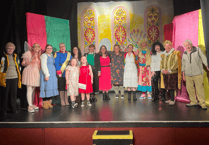Born in 1925 in Trebannos in the Tawe valley, Ogwyn Davies made his home in Ceredigion and created art that spoke of Wales.
An exhibition of his work continues at Aberystwyth Arts Centre, exploring his artistic journey over 90 years.
“What is apparent is Ogwyn never stood still with his art, it was not a typical linear journey from representation to abstraction and conceptualism, but a constant enquiry that saw him fleeting back and fore with ease between them to find the most appropriate visual language and use of materials to convey his ideas,” an arts centre spokesperson said.
“He had a fascination with materials and was always experimenting with mediums.
“At times he chose to use a more formal representational language using oil and gouache to portray farm buildings, agricultural machinery, snowy street scenes and chapels that are poetic and evocative portraits of rural Ceredigion.
“In other landscape pieces he used collage and mixed media to combine text and image where we see the words of hymns pouring out of chapels onto the mountains, buildings and sky.
“He also chooses to use the very physical ‘stuff’ of Wales – its soil and dust combined with glue to change the ‘canvas’ into a wall and an object where he scratches in words from hymns, songs, poems and voices of protest that talk of freedom, belonging and identity.
“Surface texture and an earthy palette play an important part here, emulating that of an excavated on an archaeological dig.
“He shows a mastery in calligraphy using different styles of lettering that convey different authors- sometimes alluding to ancient history as if carved by a stone mason and at other times imitating graffiti written by a protester or a prisoner in confinement.
“These ‘walls’ also echo the surface textures and palette of his ceramic work.
“What ties all the work together is that he has portrayed a sense of place, its people, its culture, its language, and his sense of belonging to it – that is his Wales.
“It is interesting that after serving as a squadron in the RAF in India, Myanmar and Sri Lanka the young Ogwyn returns home and renames his family home ‘Rhyddid’ (Freedom).
“This quest for freedom remains with Ogwyn his entire life with devolution for Wales playing an important part in the direction of his work.
“He admired and was influenced by the work of Welsh artists such as Kyffin Williams, John Elwyn and Ernest Zobole, English and Scottish artists Victor Passmore and William Scott (both of which selected his work for the National Eisteddfod visual art exhibition) with his main influence being his Catalan contemporary Tàpies.”
The exhibition continues until Monday, 12 September.




